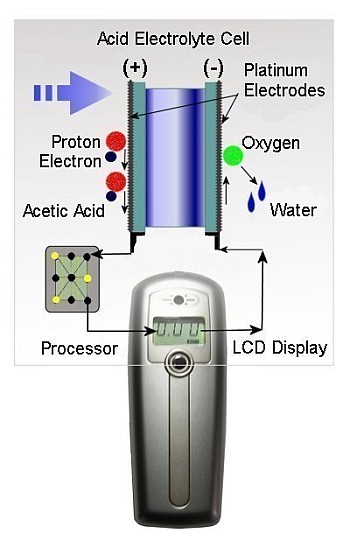Summary of How Breathalyzers Work
This article explains the importance and principles of breath alcohol testing to measure blood alcohol concentration (BAC) efficiently in the field without invasive blood sampling. It highlights the invention of the Breathalyzer in the 1940s, which measures alcohol in exhaled breath based on a chemical reaction. The article also describes the main types of breath testing devices—Breathalyzer, Intoxilyzer, and Alcosensor—and details the chemical reaction and components used in the Breathalyzer to detect alcohol levels through color changes proportional to BAC.
Parts used in the Breathalyzer Device:
- Mouthpiece
- Breath sample tube
- Sample chamber
- Glass vials containing chemical reaction mixture (sulfuric acid, potassium dichromate, silver nitrate, water)
- Photocell system
- Electric meter with needle
- Adjustment knob for meter needle
Why Test?
Alcohol intoxication is legally defined by the blood alcohol concentration (BAC) level. However, taking a blood sample in the field for later analysis in the laboratory is not practical or efficient for detaining drivers suspected of driving while impaired (DWI) or driving under the influence (DUI). Urine tests for alcohol proved to be just as impractical in the field as blood sampling. What was needed was a way to measure something related to BAC without invading a suspect’s body.
In the 1940s, breath alcohol testing devices were first developed for use by police. In 1954, Dr. Robert Borkenstein of the Indiana State Police invented the Breathalyzer, one type of breath alcohol testing device used by law enforcement agencies today.
Let’s take a look at what these tests are based on.
Principle of Testing
Alcohol that a person drinks shows up in the breath because it gets absorbed from the mouth, throat, stomach and intestines into the bloodstream.
Alcohol is not digested upon absorption, nor chemically changed in the bloodstream. As the blood goes through the lungs, some of the alcohol moves across the membranes of the lung’s air sacs (alveoli) into the air, because alcohol will evaporate from a solution — that is, it is volatile. The concentration of the alcohol in the alveolar air is related to the concentration of the alcohol in the blood. As the alcohol in the alveolar air is exhaled, it can be detected by the breath alcohol testing device. Instead of having to draw a driver’s blood to test his alcohol level, an officer can test the driver’s breath on the spot and instantly know if there is a reason to arrest the driver.
Because the alcohol concentration in the breath is related to that in the blood, you can figure the BAC by measuring alcohol on the breath. The ratio of breath alcohol to blood alcohol is 2,100:1. This means that 2,100 milliliters (ml) of alveolar air will contain the same amount of alcohol as 1 ml of blood.
For many years, the legal standard for drunkenness across the United States was 0.10, but many states have now adopted the 0.08 standard. The federal government has pushed states to lower the legal limit. The American Medical Association says that a person can become impaired when the blood alcohol level hits 0.05. If a person’s BAC measures 0.08, it means that there are 0.08 grams of alcohol per 100 ml of blood.
There are several different devices used for measuring BAC.
Types of Devices: Breathalyzer
There are three major types of breath alcohol testing devices, and they’re based on different principles:
- Breathalyzer – Uses a chemical reaction involving alcohol that produces a color change
- Intoxilyzer – Detects alcohol by infrared (IR) spectroscopy
- Alcosensor III or IV – Detects a chemical reaction of alcohol in a fuel cell
Regardless of the type, each device has a mouthpiece, a tube through which the suspect blows air, and a sample chamber where the air goes. The rest of the device varies with the type.
Breathalyzer
The Breathalyzer device contains:
- A system to sample the breath of the suspect
- Two glass vials containing the chemical reaction mixture
- A system of photocells connected to a meter to measure the color change associated with the chemical reaction
To measure alcohol, a suspect breathes into the device. The breath sample is bubbled in one vial through a mixture of sulfuric acid, potassium dichromate, silver nitrate and water. The principle of the measurement is based on the following chemical reaction:
In this reaction:
- The sulfuric acid removes the alcohol from the air into a liquid solution.
- The alcohol reacts with potassium dichromate to produce: chromium sulfate potassium sulfate acetic acid water
The silver nitrate is a catalyst, a substance that makes a reaction go faster without participating in it. The sulfuric acid, in addition to removing the alcohol from the air, also might provide the acidic condition needed for this reaction.
During this reaction, the reddish-orange dichromate ion changes color to the green chromium ion when it reacts with the alcohol; the degree of the color change is directly related to the level of alcohol in the expelled air. To determine the amount of alcohol in that air, the reacted mixture is compared to a vial of unreacted mixture in the photocell system, which produces an electric current that causes the needle in the meter to move from its resting place. The operator then rotates a knob to bring the needle back to the resting place and reads the level of alcohol from the knob — the more the operator must turn the knob to return it to rest, the greater the level of alcohol.
For more Detail: How Breathalyzers Work

